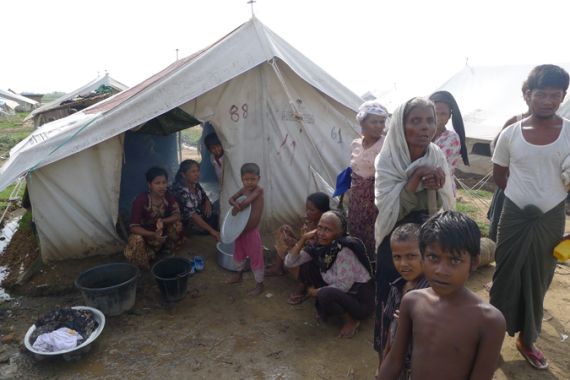Thousands of Rohingya helpless after violence
The aftermath of ethnic violence in Myanmar leaves tens of thousands of displaced Rakhine and Rohingya in its wake.

Sittwe, Myanmar – Monsoon rains have done little to dampen heated ethnic tensions in Myanmar’s northwestern Rakhine state, where dozens have died in tit-for-tat attacks over the past two months.
Scars of the conflict are visible in the charred blocks of land, where entire villages were burned to the ground by angry mobs armed with knives and metal poles.
The aftermath is particularly evident in the Narze quarter of the capital Sittwe, which has become a ghost town since the Buddhist Rakhine and Muslim Rohingya were evacuated to keep the peace.
The camps for the displaced and the villages in which they have sought refuge now house 70,000 people, according to police Lieutenant Colonel Myo Min Aung.
Violence flared after the alleged rape of a Buddhist woman and the retribution killing of ten Muslims. Days of fighting between the Rakhine and Rohingya ensued, bringing the official death toll to 78. But that is widely believed to be grossly underestimated.
The Rohingya have suffered discrimination for generations in Myanmar. About 800,000 of the Muslim group are denied citizenship under a law passed 30 years ago.
Exclusive access
| Ethnic violence displaces thousands in Myanmar |
On the streets of Sittwe, an uneasy calm is enforced by trucks carrying police and soldiers.
Bikes, scooters and tuk-tuks push slowly through heavy rain that stops as suddenly as it starts. Maroon-robed monks with bare feet make their rounds, clutching collection bowls for food.
Myo Min Aung’s police battalion, deployed to Sittwe from Yangon after local police were accused of being “anti-Muslim”, now patrol the area separating Rakhine and Rohingya settlements.
After leading the peace-keeping operation for two months, Myo Min Aung said he wants to return home to Yangon, but he is still “waiting for a plan” from the government.
In the meantime, there is a growing humanitarian crisis that, until now, few outsiders have been able to see.
In a move that perhaps says something about Myanmar’s shift toward openness, Al Jazeera was given access to Sittwe and the refugee centres that house the displaced.
On the outskirts of town, about 50,000 Rohingya are residing in a cluster of camps and villages.
The Kaung Dokar Refugee Camp is one of six official shelters for Rohingya in Sittwe township. A vast grid of white tents pegged into the mud of a treeless plain, it’s a no man’s land of rationed food, boredom, and days ended by a 6pm curfew.
“I want to go home because when it rains here in the camp, the water rises up,” says Rezu Mar Bibi, a young woman who speaks as a crowd of onlookers pushes closer to hear. “If I can’t go back home, I want to go to another country.”
Shortages
Camp residents are desperate to tell their stories, of family members killed, wounded or missing.
Food rations of rice, beans and oil are not enough, they say, a claim confirmed by Myo Min Aung who is tasked with ensuring that what little food arrives does so safely.
Some of the complaints by the Rohingya are echoed by the 20,000 displaced Rakhine sheltering in the area’s Buddhist monasteries.
Families in these religious centres rest in groups on the floor, some with bags holding the few possessions they were able to carry with them when they fled burning villages.
Saw Saw, a Rakhine fisherwoman who lost her home and all its possessions, said she can no longer work. She has access to the market, but no income to pay for goods.
When asked if Rakhine and Rohingya can live together in the future, she says it’s unthinkable.
“It’s not possible because these people are very cruel,” Saw Saw said, voicing fears that Rohingya from other countries could come and “cause more trouble”.
It’s an attitude that permeates through Myanmar. Most people here refer to Rohingya as “Bengalis” or “guests”. Some believe they are Bangladeshis who have illegally paid to enter Myanmar through the porous border.
“If they pay the bribe, they can become a Myanmar citizen,” says Master Oo Ku Maar Ka, head of the Gade Chay Buddhist monastery. The authorities “are not protecting our religion, our culture and our race”, he said.
Groups separated
The government refuses to recognise Rohingya as citizens, even though many say they have lived in Myanmar for centuries. In the initial aftermath of the violence, President Thein Sein called for Rohingya to be “settled in refugee camps managed by UNHCR”.
“If there are countries that would accept them, they could be sent there,” Thein Sein said.
It is a frustrating situation for Rohingya in the camps and villages. “As we are born in Myanmar, we must be Myanmar citizens,” said Abu Shukur, a refugee living in a village outside Sittwe.
UK-based activist group Restless Beings, which has closely followed the crisis, has said Myanmar should recognise “rights for all ethnic minorities and… Rohingyas as citizens of the country”.
Myo Min Aung said the government, under pressure from the international community, is now researching options for dealing with those displaced.
In the meantime, the division, suffering, and potential for violence continues.
Myo Min Aung’s officers can only separate the two groups, hoping monsoon rains douse the flames of any new sectarian flare-ups.